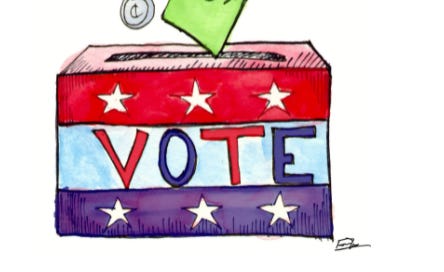It has been one year since we launched our newsletter! Happy Birthday to 2xParked!
I am back after a brief hiatus, and although our weekly cadence likely will not continue, there is still a lot of data to investigate, especially after Election Day 2021.
There was very little doubt in my model (or my mind) that Eric Adams was going to be victorious on Tuesday. Adams entered as the favorite the moment he announced his candidacy, coming with a 41% chance of winning in his first appearance in the MayorModel. Although he received challenges in the form of high profile opponents and losing out on key endorsements, the voters soundly chose Adams.
What I find more interesting about Tuesday from an NYC and data perspective are the five ballot proposals. When I arrived at my voting station, I was as aware of these initiatives as I was of all the candidates running for Brooklyn judgeships. I took my time, read through the voting language, and tried to make my best guess as to how I personally felt.
Now that the results are in, and many NYC politicians are complaining about the public awareness these initiatives were given after the fact. Although the complaints are more along the lines of “these did not go my way, so someone has to be blamed”, it brings up an interesting question: should someone be blamed? What does the data say?
The first question I investigated: were people randomly choosing “yes” or “no”?
This question is pretty easy to answer. If we assume the voting population as a whole was choosing randomly, then we would assume that the vote would be split 50/50.
It is clear and obvious from the aggregated results that these voters were not chosen at random. The blue filled dots represent the actual percent of “yes” votes (and their subsequently small confidence bands) and the orange dots are 50% (ie random). If they were random, you would expect the orange dots to be in the little blue blob right in the center. Clearly they are not.
On aggregate the voters were not choosing at random, but there certainly were a lot of voters rolling a dice. Were there enough non-random votes to truly represent NYS? This is a much tougher question to answer, but we can try.
Using past data, I first determined how much of the vote is random. This required assumption-making on my part from prior proposals with no support (political or financial) and those with a lot. I determined ⅓ of the vote on measures is random “yes” or “no”, which is a lot compared to votes for major politicians. If we remove these random voters, we see the affirmatives are more affirmative and the opposition are more opposed. But this also significantly reduced the number of voters in this deciding voter pool.
How do these remaining voters represent the sentiment of the population as a whole? Assuming this ⅓ randomness and the population is potential NYS voters, the margin of this population would be within 0.08% of what the true public sentiment with 99% confidence. This is not enough to doubt the results.
You might argue and say it was (1) more random this year than the past, (2) a random voter is more likely to vote “yes” than “no”, and (3) the population should be all of NYS and not just the voters. Let’s look at this most extreme example. 65% of odd year initiatives pass the voter test, let’s assume a random voter is 65% likely to say “yes” randomly (and 35% likely to say “no”). This means given the results that there could be a maximum of 66% of voters voting randomly. If NYS has 19.5M residents, then the margin with 99% confidence on these initiatives would be 0.13%.
So it can be argued these measures passed or failed on their own merit.
The bigger discussion is more philosophical. No money was spent on these campaigns, which is common. Most proposals do not have money spent in favor or in opposition. On the one hand, more money could have made the public better informed. On the other, there is a big argument on both sides that it is wrong to buy votes. Either way, the onus is on the voters to do their research, not on the politicians or the political parties.
I will let you take the initiative to decide.





